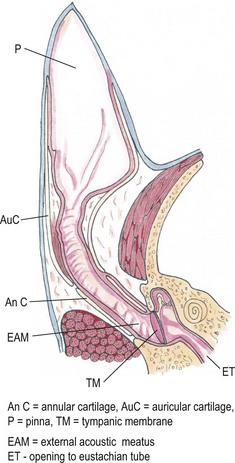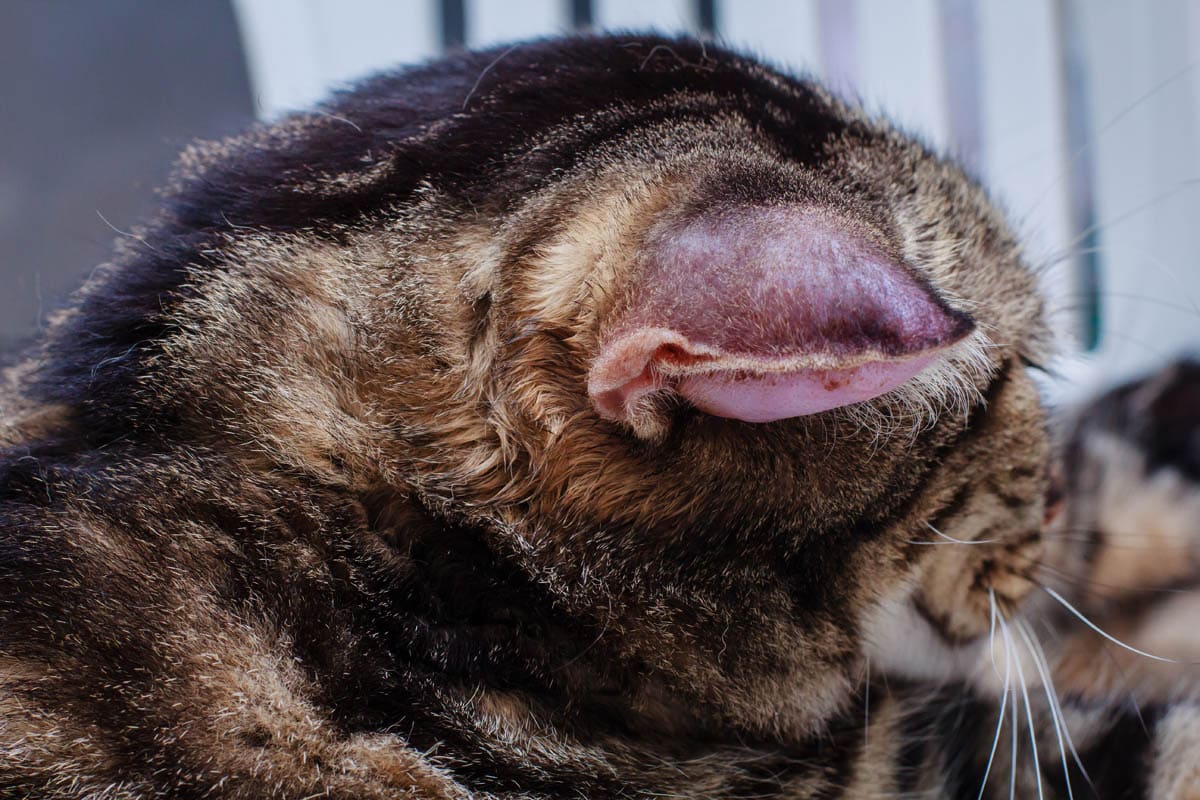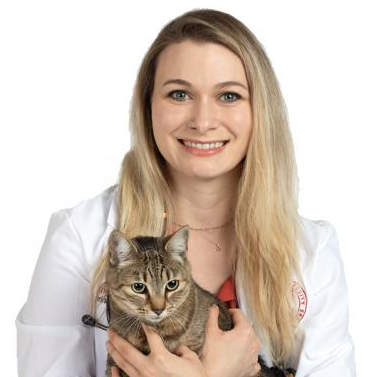What is cauliflower ear?
Also known as a perichondral hematoma, cauliflower ear is an irreversible deformity caused by the formation of scar tissue and contraction of the perichondrium which occurs after a separation of the ear cartilage from the underlying connective tissue.
The pinna is the outer part of the ear that acts as a funnel to direct sound further into the ear and is made up of three layers:
- Cartilage plate: The innermost layer of the pinna provides shape and rigidity. Unlike other tissues, the cartilage cannot heal itself when damaged.
- Perichondrium: A protective layer of connective tissue that provides the blood supply and nutrients to the cartilage. The underlying cartilage and the overlying skin are both firmly attached to the perichondrium.
- Skin: The outermost layer of skin that is covered with short hairs on the outside.

As the cat scratches the ear or shakes the head (head shaking is more common in floppy-eared dogs), the perichondrium separates from the cartilage which creates space. The perichondrium blood vessels rupture and blood pools in the pocket-forming a hematoma. This build-up of blood between the perichondrium and cartilage can interrupt the blood and oxygen supply to the cartilage causing necrosis.
The distortion of the pinna, which becomes hard and cauliflower-shaped (hence the name) is thought to be due to a combination of factors which include myofibroblastic contraction of the maturing granulation tissue, excess cartilaginous tissue (preexisting and newly formed), and the separated perichondrium retracts and acts as a bowstring, gradually folding back the cartilage.
What causes perichondrial hematoma in cats?
The most common causes of trauma are ear infections, ear mites, allergies, foreign body (such as a grass seed), or a direct hit to the pinna from trauma.
Cauliflower ears are common among boxers, wrestlers, and rugby players who frequently experience blunt force trauma to the head and ears.
Ear hematoma symptoms

The most common symptom of an ear hematoma is a localized swelling of the pinna which takes on a balloon shape. The area feels warm to the touch and is extremely painful.
Cats with ear hematomas may be uncomfortable, shake their head frequently, and scratch at their ears.
Treatment
Ear hematomas can be addressed by draining the ear, placing multiple sutures in the ear, or bandaging the ear to prevent further damage, which allows the underlying tissues to re-adhere and avoids the hematoma recurring.
The cat will be given pain relief for the first 24-48 hours after surgery. An Elizabethan collar may be necessary to prevent your cat from scratching the area. Sutures and bandages will be removed 2-3 weeks post-surgery.
Some veterinarians prefer to medically manage ear hematomas before surgery is considered. Some will treat the underlying cause of the hematoma and consider the use of an anti-inflammatory to reduce the inflammation. The ear may or may not be drained.
Cauliflower ear is irreversible and there is no treatment.
Prevention
The best way to avoid cauliflower ear in cats is to treat ear mites and infections quickly and seek prompt veterinary attention if the cat develops an ear hematoma.
What if cauliflower ear is left untreated?
If left untreated the swelling may progress and can become painful to your cat. If your cat is shaking or scratching excessively, this area can become ulcerated or infected. The pinnae may even rupture if it becomes extremely swollen. The longer the hematoma is present, the greater the chances of cauliflower ear developing.
Is cauliflower ear painful to cats?
Moderate to severe cases of ear hematomas are painful. Once the swelling has subsided and cauliflower ear develops, it is no longer painful.
When to contact your vet
It is best to contact a veterinarian before clinical signs of a hematoma develop. If you notice your cat is shaking their head, scratching its ear, or has a head tilt, these are all signs of discomfort. An appointment should be made. Mild swelling may not need to be medically addressed but the underlying condition causing the hematoma should be. Painful hematomas should be addressed right away so treatment can be initiated before they become more severe.
Frequently asked questions
Can the swelling simply be drained?
- Yes, some veterinarians will want to drain the fluid in the pinnae. This technique does not prevent the swelling from returning but may provide comfort for your cat while the underlying condition is treated.
Can it go away on its own?
- Mild cases of ear hematomas will likely resolve without intervention as long as your cat is not causing further trauma to the ear. Moderate to severe cases require intervention.
Are cauliflower ears genetic?
- No. Cauliflower ears are a complication of damage to the pinnae of the ear.
Can an ear hematoma burst?
- If an ear hematoma becomes severe or is traumatized by scratching, there is potential for rupture.
How much does cat ear hematoma surgery cost?
- Surgical prices vary depending on the veterinary clinic. Most cost anywhere between $300-1200.
Are there effective home treatments?
- Ear hematomas are unlikely to improve with home remedies. The mainstay of treatment is resolving the underlying cause with topical ear medications and cleaning. At home, you can clean your cat’s ears if an infection is suspected. There are also special head wraps designed to prevent worsening of the hematoma.

